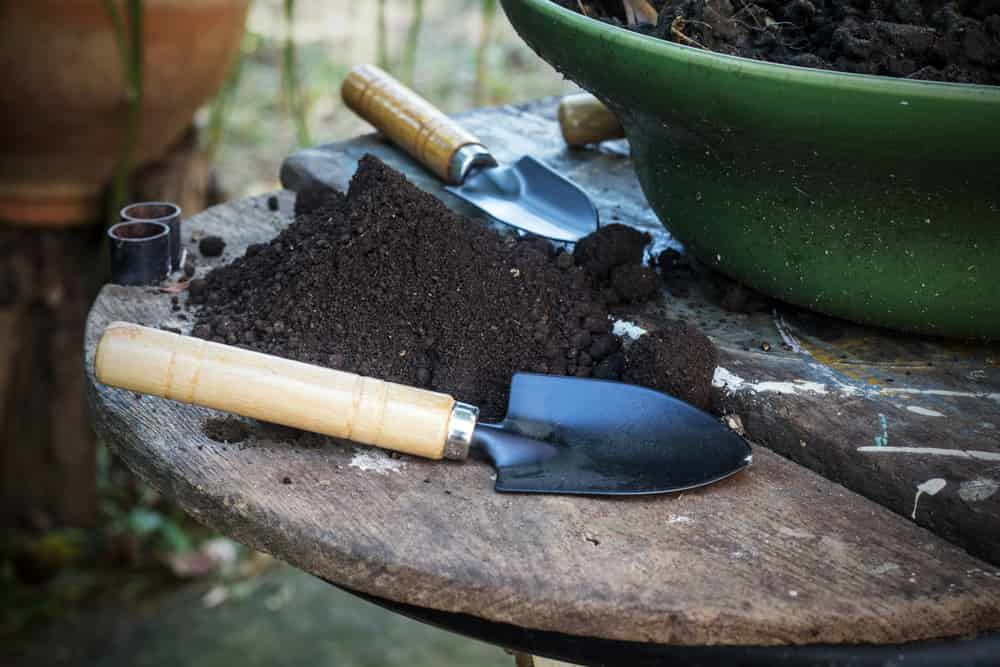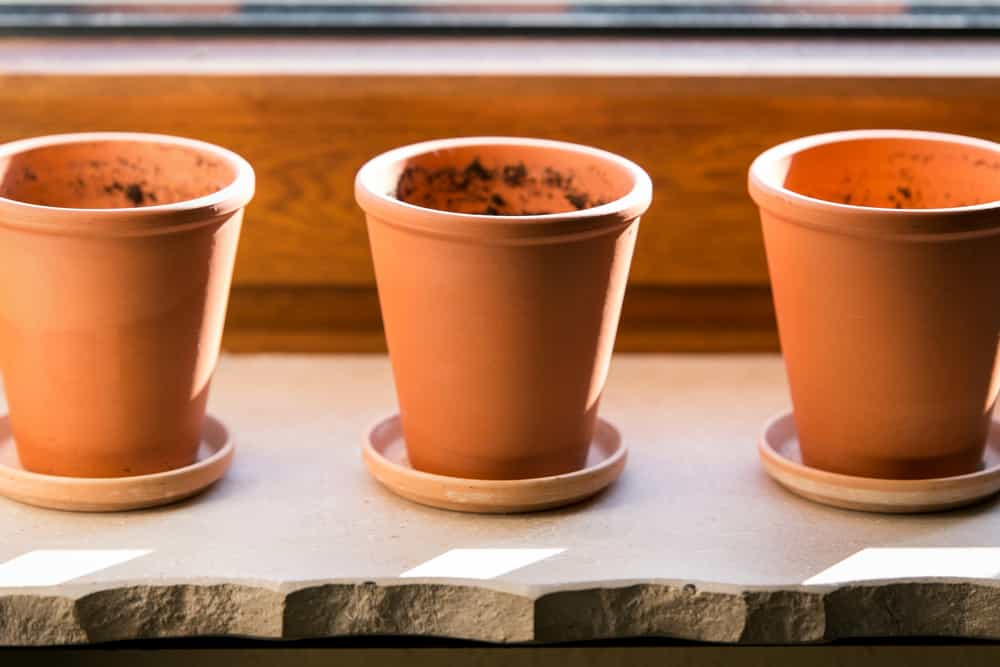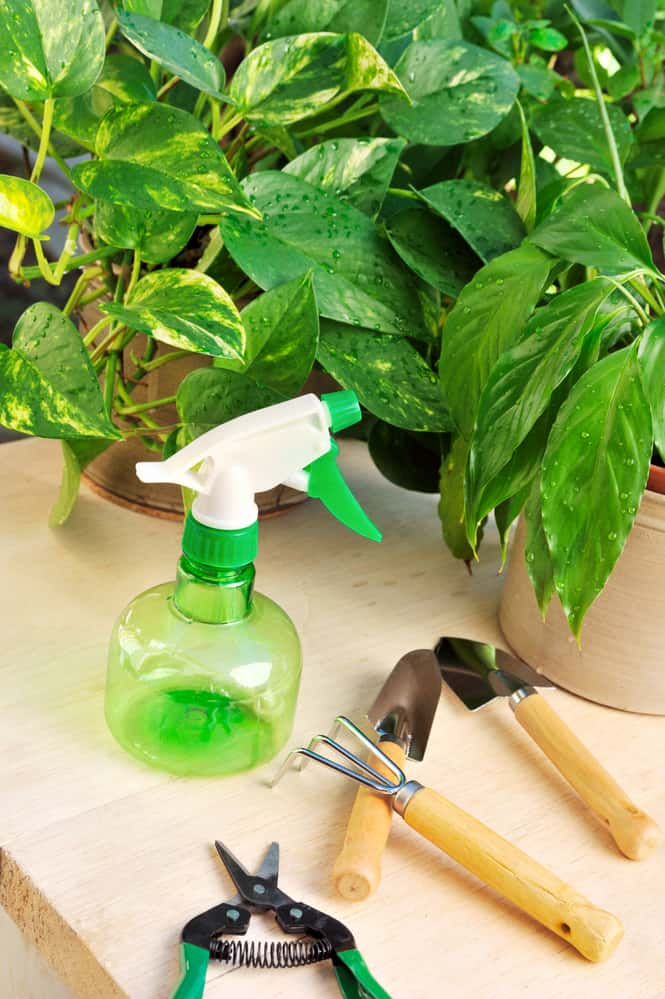Not only are pothos plants beautiful, with their shiny green, heart-shaped leaves, but they’re also easy to care for, requiring very little short-term maintenance – including, importantly, that you don’t have to repot pothos that frequently.
That said, if you really want to see your pothos thrive, there are a few steps you can take to ensure it preserves optimal health. Part of this is, of course, keeping a regular care regime in terms of water, light, and humidity.
Additionally (and importantly), you may also want to keep an eye on its size to ensure it doesn’t outgrow its pot.
Repotting pothos can feel intimidating, primarily because of their delicate roots and vining growth patterns, but in this article, I’ll take you through the process step by step. In no time, you’ll be able to confidently rehome your plant and provide it with extra space to reach its full potential.
Ready? Let’s dive right in.

Table of Contents
Why should I repot a pothos?
The two primary reasons for repotting pothos plants are that they’ve outgrown their existing planters or they’re suffering from ill health. Giving your pothos a bigger pot will allow it more room to grow and prevent it from becoming rootbound. Alternatively, a new turn of soil can eradicate bacteria and fungus causing your pothos distress.
Before we get into the nitty-gritty of how to repot pothos, it’s valuable first to understand why and when to do so. Transplanting your houseplants is part and parcel of their maintenance and care, but it can also be distressing to them and should be reserved for only when necessary.
As mentioned, the two primary reasons to repot pothos are to improve their size or health. These gorgeous plants, as you know, are relatively fast-growing. Therefore, over time, it’s only natural that they’ll become too big for their pots.
Pro tip: To check if your pothos needs a new home, wait until it’s relatively dry and gently lift it from its pot to inspect its roots. If they seem voluminous and tangled, or they’re peeking through the drainage holes, it’s time for a new planter.
Another reason to repot pothos is if your plant shows signs of ill health (like if you have a drooping pothos or it’s wilting). After a long period in the same soil, bacteria and fungi may start to grow, which can turn into a bigger problem over time.
Moving your plant into fresh ground can help eliminate these harmful pests, improving your plant’s chances of full recovery.
Now that you know why to repot your pothos, let’s take a detailed look at moving your plant into its new home and the steps you can take to make it as seamless as possible.
Do pothos need bigger pots as they grow?
Pothos need to be moved into bigger pots as they get larger, or else they’ll struggle to grow. With no space to extend, roots become bound and tangled, making it difficult to draw in oxygen and nutrients, which can also lead to a heap of health issues.
If you notice that your usually robust pothos has started to slow its growth, it may be a good time to inspect its roots’ space. That said, the size of your plant itself should be enough to indicate if it’s outgrown its home.

How to repot pothos
Repotting pothos is an integral part of maintaining their overall health and well-being. The most crucial part of the process is gently removing your plant from its existing soil without damaging or breaking any roots. From there, you can safely transplant it into a planter prepared with soil and douse it liberally with water.
Most of us love our pothos plants because of their wild and whimsical vines. That said, this growth pattern is the very thing that makes them so scary to transplant. There’s always a risk you can damage your pothos in the moving process. But the best you can do is put measures in place to ensure you work as gently as possible.
Once you’ve identified that your pothos needs to be rehomed, either because it’s grown too big or you’re concerned about its health, it’s time to shop for your new pot. I recommend going for something 2 to 4 inches (5 to 10 centimeters) larger in overall diameter. It’s great if it’s a little deeper, too.
Once you have your planter ready, you can prepare your workstation and soil and then shift your plant to its new home. But before you do, there are some preemptive steps you can take in the days leading up to the move that will make it easier for you overall.
Related: 11 Best Pots For Your Pothos (and What to Avoid)
1. Prepare your pothos for transplanting
In my experience with plants, I’ve often encountered the question of whether one should water a plant shortly before repotting it. But the answer to this question is two-fold.
For one – yes, it’s great if your plant is energetic and well-hydrated before a move. This means it will be at its most robust and most productive, making it less likely to suffer transplant shock. Unfortunately, though, wet soil is heavy and can put unnecessary strain on a root system.
Therefore, my recommendation is to water your pothos two days before you plan to repot it. This will account for sufficient moisture in the soil, but it won’t be clogged or soggy and is, therefore, less likely to cause breakage.
You may also be interested in: How Often to Water Your Pothos (So It Thrives)
2. Prune away dead growth
“Out with the old, in with the new” is valid for your houseplants too. Before repotting, give your pothos a thorough once-over to remove any dead or decaying growth so that it doesn’t expend excess energy on leaves and stems that have gone past their sell-by dates.
Occasional pruning of pothos is always advisable but try to keep it to a minimum if you can. For repotting, you really only need to get rid of dead leaves. Conversely, pruning for aesthetic or training purposes should not be conducted before repotting, as this can cause extra distress.
3. Prep your workstation
When exposed, roots can become susceptible to picking up bacteria or fungi. Therefore, before repotting, make sure you have a clean and spacious workspace available for the process. Usually, I prefer to lay down a plastic bag or sheet to avoid making a big mess, too.
If you’re pruning away dead growth ahead of transplanting, also ensure your cutting tools are clean and sterilized. This reduces your chances of spreading bacteria between plants and gives your pothos their best chance at a speedy recovery from moving.

4. Prepare your new planter with soil
When transplanting any type of plant, you want to minimize their roots’ exposure to air. For this reason, it’s crucial that you have your new planter and soil ready for when you remove your pothos from its old pot.
With your new pot on hand, it’s time to fill it with soil. I always select the best top-quality potting soil for pothos and mix it lightly with some perlite for moisture retention and air circulation. At this stage, you only need to fill your pot one-third of the way. But keep the rest of your fresh ground on hand, as you will be packing it around your pothos once you’ve positioned it in the pot.
5. Remove your pothos from its old pot
Removing your pothos from its old pot is the most delicate part of this process, for sure, so you want to work slowly and carefully. As you know, your soil shouldn’t be soggy but rather just slightly moist.
To slide your pothos out of its planter, hold it at a 45-degree angle and gently maneuver it outwards. Try to get a hold of your plant as close to its base as possible, rather than tugging on its stems or leaves.
Once free from the pot, work away the existing soil with your fingertips. When the bulk is removed, you can shake the roots lightly to shed the excess. At this point, you can also very delicately separate any twisted and tangled roots.

6. Place your pothos in its new planter
Breathe a sigh of relief. The hard part is over. Now all that’s left to do is place your pothos in its new home.
Position your pothos in your partially filled pot, as close to the center as possible. Next, carefully fill the space around the roots and base with the rest of your prepared soil. Use your free hand to support your plant while you do this.
Once your pot is filled, gently press down on the soil to ensure your pothos is relatively supported. However, don’t press so hard that it becomes compacted, as this can damage the root system.
7. Care for your transplanted pothos
With your pothos rehomed, all that’s left to do is give it some water and plenty of sun to reinvigorate it. Don’t drench or overwater your pothos plant; instead, just give it the same amount of water you usually would. Make sure it’s draining through, then place it in a spot with plenty of sun and humidity.
FYI: The pothos may look droopy for a few days just because of the shock, but with proper care, it should be up and at ‘em in no time.
When should I repot my pothos plant?
Plants are famously affected by the seasons, and pothos is no different. For this reason, it’s advisable to only repot your plants during their growing seasons, which in the case of pothos, are spring and early summer. This is when they’re at their most robust and healthy and most likely to grow and thrive.
While pothos are incredibly hardy, they can get a little slow in the colder months of the year. Because they don’t receive as much sunlight as normal, they have less energy available to convert nutrients from the soil. Less energy also means they don’t recover from significant changes as easily.
For this reason, you should hold off on repotting your pothos until spring or early summer. During this time, they really thrive, so a little transplantation won’t place them at a high risk of experiencing health issues.

How to repot a pothos with a moss pole?
Repotting your pothos with a moss pole will give it a secure place to climb and vine upwards. Insert your pole at least three inches into the soil so it doesn’t topple over. Then, gently wrap your vines around the pole, using plant ties to keep them in place.
At the point of adding your moss pole to the pot, ensure it’s at least two inches away from the plant’s primary roots so as not to cause any damage.
Moss poles serve the dual benefit of giving your pothos something to attach to while also providing it with additional nutrients. In terms of looks, they also offer a beautiful and manicured aesthetic. It also serves as a simple step to train your pothos to climb.
Repotting your pothos with a moss pole is much the same as repotting it without one in terms of process. Your first port of call is to ensure your plant is safely moved and then to insert the pole so that it doesn’t hurt any roots.
At first, it may look a little barren, and you’ll need to adhere your stems with plant ties to keep them up until they attach themselves. In a few weeks, you should start to notice new growth, at which stage you can remove the ties.
I recommend rotating your plant once a week or so that it receives sunlight from every angle. This will help it to take on a consistent growth pattern by circling around the pole in search of the sun.
Related: What Are Your Pothos’ Light Needs (So Your Plant Can Thrive)?
How to repot pothos from water to soil
Pothos stem cuttings can be propagated in water and are ready to be planted in soil once they show new root growth of around two inches. To plant pothos from water into soil, fill a pot about halfway with fresh ground, position your cutting, and then fill in the area around it up to the base of the plant.
Propagating pothos is exciting – especially because they’re such gratifying growers. If you’ve successfully rooted some stem cuttings in water, it’s time to move them into a pot.
To do so, you can follow the steps laid out earlier in this article almost to a tee. The only difference is you won’t need to get rid of any old or problematic soil. Smaller plants may also initially benefit from the addition of a support stake.
On that point, I’ll add a quick note on staking or including moss poles in your potting process. Stem cuttings are usually much more sparse than mature plants, meaning they could do with a little extra support. In this regard, I would consider resting them against a small stake. Alternatively, give them a moss pole from the get-go, so they can learn to climb around it.
Related:
Should you water pothos after repotting?
Yes, you should always water pothos after repotting. This will help it to convert nutrients from the soil into energy by transporting them to the plant’s stems and leaves. That said, don’t overwater your plant immediately, as this can make the ground heavy and saturated, which will suffocate the roots.
It’s no secret that pothos love water, which, ultimately, is their life source. Fresh soil is often dry, so once transplanted, you’ll need to give them some hydration to activate their energy for drawing in the nutrients they need to thrive.
However, do remember that your pothos has undergone a significant change and will be in a more delicate state of health for a few days. It’s essential that you don’t overwater your plant. Instead, give it enough so that you see mild drainage from the bottom of the pot. Then, empty out the drip tray (pothos don’t like wet feet!), and set it in the sun to warm up.

Why is my pothos dying after repotting?
Pothos can suffer ill health after repotting due to existing ailments, like root rot or a pest infestation, or because the pot is too large, and the soil is too wet or heavy. Repotted plants often suffer from transplant shock, which is a temporary condition of fragility as a consequence of a significant environmental change.
We’ve all been in a position where a much-loved plant suddenly starts to droop or pothos leaves turn yellow for seemingly no reason at all. The risk of this happening is significantly higher if your pothos is undergoing transplant shock, during which they’re more susceptible to poor health.
But don’t beat yourself up too much. Some plants do have preexisting conditions, like root rot or pests, that become amplified once they’re repotted purely because they’re distressed. For this reason, always check that your plant is robust and healthy before moving it.
Keep in mind: Another reason a repotted pothos can start to fade is from irregular watering practices, like if you have an over- or underwatered pothos. It may also be because their new pot is too big and not drying out quickly enough. In the latter case, saturated soil crushes their roots, making it impossible for them to transport nutrients.
New pots should be one size up and usually only need to be replaced every 18 to 24 months.
How long will my pothos be in shock after repotting
In good news, pothos should recover from transplant shock after about two to three weeks, max. Initially, they will come across as a little worse for wear, but as soon as they’ve settled (with proper care), they’ll be back to their old selves.
Should they still look unwell after four weeks, you may need to explore other avenues, like root rot or pests, that may be causing them distress.
